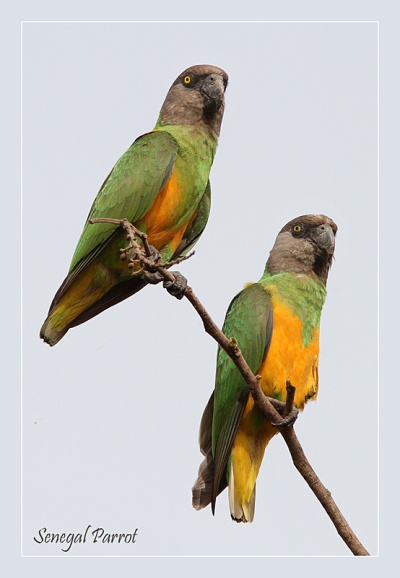- Poicephalus senegalus
Identification
23 cm (9 in)
- Charcoal grey head
- Green upperparts, breast and wings
- Yellow belly, becoming orange in the centre
- Greenish-brown tail
- Yellow underwing-coverts
- Yellow iris
Juveniles have a dark grey, almost black, iris
Distribution
Western Africa: found in Mauritania, Senegal, The Gambia, Guinea-Bissau, Guinea, Mali, Sierra Leone, Ivory Coast, Ghana, Togo, Nigeria, Niger, Chad, Cameroon, Central African Republic
Taxonomy
Subspecies
There are 2 subspecies[1]:
- P. s. senegalus:
- Gambia and Guinea-Bissau to southern Niger, northern Cameroon, south-western Chad
- P. s. versteri:
- North West Ivory Coast to south-western Nigeria (south of range of senegalus)
Habitat
Open woodland and lowland savanna.
Behaviour
Breeding
They nest in holes in trees, often oil palms. The clutch consists of 2-3 white eggs which are incubated by the female for about 28 days, starting after the second egg has been laid. They fledge after 9 weeks and are independent at 12 weeks.
Diet
Their diet consists of fruit, seeds and blossoms. They also eat maize and millet and are considered a pest.
References
- Clements, J. F., T. S. Schulenberg, M. J. Iliff, D. Roberson, T. A. Fredericks, B. L. Sullivan, and C. L. Wood. 2017. The eBird/Clements checklist of birds of the world: v2017, with updates to August 2017. Downloaded from http://www.birds.cornell.edu/clementschecklist/download/
- Avibase
- Handbook of the Birds of the World Alive (retrieved Nov 2017)
- Wikipedia
Recommended Citation
- BirdForum Opus contributors. (2025) Senegal Parrot. In: BirdForum, the forum for wild birds and birding. Retrieved 27 April 2025 from https://www.birdforum.net/opus/Senegal_Parrot
External Links
GSearch checked for 2020 platform.1




